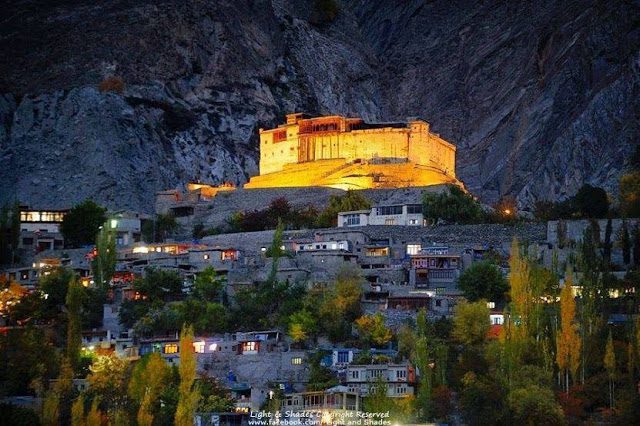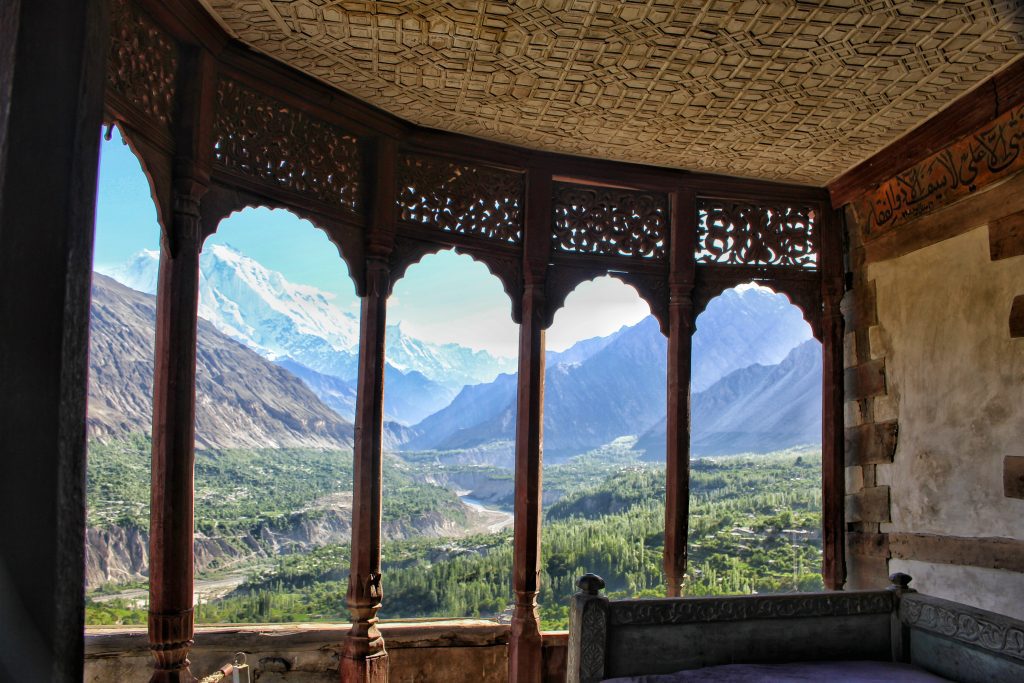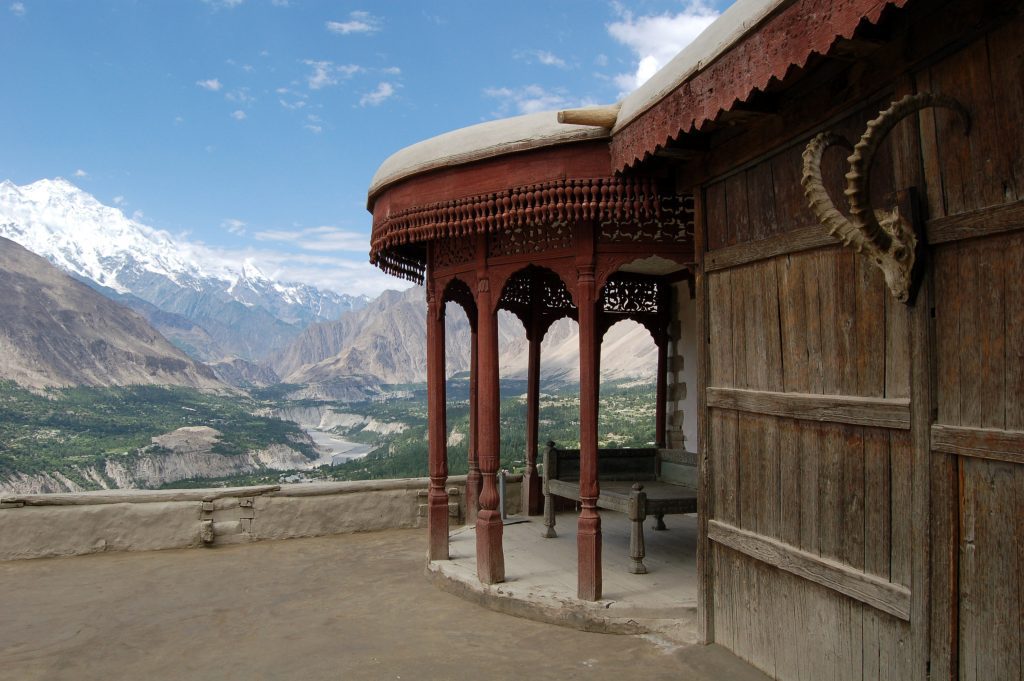
The Baltit Fort stands on moraines of Ultar glacier in the central Hunza Valley, among the Karakorum range in the Gilgit-Baltistan region of Pakistan.

The rich beauty of Baltit Fort can be traced back 700 years, to Ayasho ll, Tham/Mir (ruler) of Hunza, who married Princess Shah Khatoon (Sha Qhatun) from Baltistan in the early 15th century. This fort is the first ever to be restored
(1990-96) by the Aga Khan Trust for Culture, as a pilot project of currently on-going conservation of a number of
monuments of northern Pakistan. The trust is also active in the restoration of monuments and historio sites in
Khyber Pakhtünkhwa (Vazir House Swat) and in Punjab (Shahi Hammam and Wazir Khan Mosque). The Fort remains open all year round and seven days a week, with the idea of being a self-sustaining cultural centre
supported by the sale of entry tickets, souvenirs and generous donations of individuals and organizations interested for the promotion and preservation of cultural and historical heritage of this part of world. In olden times a nu gber of small independent states existed in the
Northern Areas of Pakistan. Among them, Hunza and Nagar were the traditional rival states, situated on opposite sides of the Hunza (kanjut) river. The rulers of these two states, known,.as Tham, built various strongholds as es ressions’ a their power. The Hunza rulers initially resided in the Altit Fort, but later, as a result of a conflict between the two sons of the ruler (Sultan), Shah Abbas (Sháboos) and
Ali Khan (Aliqhán), Shaboos shifted to the Baltit Fort, making it the capital of Hunza. The power struggle between the two brothers eventually resulted in the death of younger one, and Baltit Fort established itself as the seat of power in the Hunza state. Ayasho ll, Tham was the first to modify the face of Altit and, subsequently Baltit
Fort. Baltistan – the land of Balti people hạd a strong cultural and ethnic. Northern Areas of Pakistan. Among
them, Hunza and Nagar were the traditional rival states, situated on opposite sides of the Hunza (kanjut)
river. The rulers of these two states known as Tham, built various strongholds as expressions of their power. The Hunzarulers . vally resided in the Altit Fort, but later, as a result of a conflict between the two sons of the ruler (Sultan), Shah Abbas (Sháboes)land: Ali Khan (Alighán), Shaboos shifted-te the Baltit Fort, making it the capital of
Hunza. The power struggle between the two brothers eventually resulted in the death of younger one, and Baltit Fort established itself as the seat of power in
the Hunza state. Ayasho ll, Tham was the first to modify
the face of Altit and, subsequently Baltit Fort. Baltistan – the land of Balti people had a strong cultural and ethnic
relationship with the Ladakh region of undivided India. Consequently, the structure of Baltit Fort was influenced by the Ladakhi/Tibetan architecture, with some resemblance to the Potala palace in Lhasa. Additions, renovations and changes to the building were made through the centuries by the long line of rulers of the Hunza region which was on the historic Silk Route. One of the biggest changes in the
structure of Baltit Fort came with the invasion of British in December 1891, which resulted in Tham/Mir Safdarali
Khan, ruler of Hunza, his wazir Dadu (Thara Baig II), fleeing to Kashgar (China) for political asylum with their companions and families. The Baltit Fort is a wood-and-stone structure with mud plaster. It is a three story building, with granaries and some stores in the basement on a glacier moraine hill with man-made narrow terraces for the stability of its ancient foundations. Bilateral relations between Hunza and Nager had remained fractured right from the very first episode of installation of Mirs from Gilgit in 9th century. After consultations with the warlords of
Hunza, Mir Ghazzan Khan 1 decided to manufacture, in the very first year of his reign, a cannon in Hunza in early 1863,to face the alarming political conditions around Hunza. News coming from across the river indicated that the rival State of Nager had invited Hassan Afendi from
Kashmir for crafting a cannon. Mir Ghazzan Khan 1 managed to acquire the services of a cannon designer, Adina Baig from Badakhshan in Central Asia. He initially faced shortage of material, but discovered a solution in a short span of time and by accumulating local material and services. This led to the successful manufacturing of the cannon before the rival state of Nager Hunza State victoriously test fired its cannon in 1863, and is on display at Baltit Fort, signifying its importance in local history. An ancient collection of sword and weapons, mostly brought from China and Russia. With the conquest of Hunza and Nager states by the British forces in December 1891, the fortified wall and watch towers of the old Baltit village and watch towers of the Fort on its north-western end were demolished on the directions of the British authorities. A side view of the Baltit Fort, overlooking the valley of Hunza River. The British installed Tham/Mir Sir Muhammad Nazim Khan K.C.I.E, as the ruler of Hunza State in September 1892. During his reign, he made several major alterations to the Baltit Fort. He demolished a number of rooms on the
third floor and added a few rooms in the British colonial style on the front elevation, using lime wash and coloured
glass panel windows. Baltit Fort remained officially inhabited until 1945. The second floor features an impressive open terrace with a royal throne under a beautiful Mogul style wooden cane-y living rooms, bay windows with balcony and breath-taking views. The Fort is set amidst the Hunza and Nager Valleys, which are on either side of River Hunza, running from east to west.The the area is surrounded by mountains like Rakaposhi (7788m), Diran Peak (7257m), Golden Peak (7027m), Ultar
(7388m), and Bubulimoting (“Lady Finger”, 6000m). Diwan-e-Khas- the royal chamber reveals a creative face of how the rulers lived. This room was used as a guest house
winter bedroom of the Mir of Hunza and private meetings in olden times. Placed here were different artifacts
portraying-the social coherence that prevailed during the regime of the Royal family. Prominent artifącts include Stone Age. cooking warest imported carpets, mystic
carvings and water sets brought from China. Rugs that enhance the environment were the main production of Hunza. There was a trend amongst the prominent families of Hunza of bringing carpets from China or purchasing them from the trade caravans that moved along the Silk Route, and they were not manufactured in the area till the late 1990s. This carpet was made in Khutan (China), some 300 years ago. Tibetan musical instruments, Chinese
currency notes, Kashmiri glass work, local rugs, colorful royal seats and string musical instruments used during the
recitation of devotional poems (qasayid) from Persian literature during religious gatherings in Rani Kott, and provide a glimpse of the cultural links with neighbouring cultural regions. The sitting area of the Fort, with old
carved wooden cabinets and decorative plates.
The sitting area
The first floor of the Fort has most of the stores, the main kitchen (pictured here), guard rooms, a dungeon and a winter guest room. They are connected to each other by elaborate labyrinths. Featured here are some antique local
artifacts. The Fort’s beautiful wood carvings are eye-catching, and were adopted in many later buildings in Hunza valley. The structure’s wooden cribbage work (known locally as Kator), is the real reason of its stability over so many centuries, despite various natural hazards.

http://artsandculture.google.com

